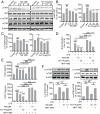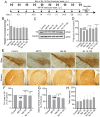Nardostachys jatamansi Extract and Nardosinone Exert Neuroprotective Effects by Suppressing Glucose Metabolic Reprogramming and Modulating T Cell Infiltration
- PMID: 40358168
- PMCID: PMC12071694
- DOI: 10.3390/cells14090644
Nardostachys jatamansi Extract and Nardosinone Exert Neuroprotective Effects by Suppressing Glucose Metabolic Reprogramming and Modulating T Cell Infiltration
Abstract
Background: Nardostachys jatamansi DC. (Gansong), a widely utilized herb in traditional Chinese medicine, has been historically employed in the management of various neuropsychiatric disorders. Nardosinone (Nar), a sesquiterpenoid compound, has been identified as one of the principal bioactive constituents of N. jatamansi. This study investigated the effects of ethyl acetate extract (NJ-1A) from N. jatamansi and its active constituent nardosinone on neuroinflammatory mediator release, glucose metabolic reprogramming, and T cell migration using both in vitro and in vivo experimental models.
Methods: Lipopolysaccharide(LPS)-induced BV-2 microglial cells and a 1-methyl-4-phenyl-1,2,3,6-tetrahydropyridine/probenecid (MPTP/p)-induced male C57BL/6N mouse chronic model of Parkinson's disease were applied.
Results: Both NJ-1A and Nar could significantly suppress LPS-induced production of M1 pro-inflammatory factors or markers in microglia and could inhibit the glycolytic process and promote oxidative phosphorylation via the AKT/mTOR signaling pathway. Furthermore, they exhibited the capacity to attenuate chemokine release from activated microglia, consequently reducing T cell migration. In vivo experiments revealed that NJ-1A and Nar effectively inhibited microglial activation, diminished T cell infiltration, and mitigated the loss of tyrosine hydroxylase (TH)-positive dopaminergic neurons in the substantia nigra of MPTP-induced mice.
Conclusions: NJ-1A and nardosinone exert neuroprotective effects through the modulation of microglial polarization states, regulation of metabolic reprogramming, and suppression of T cell infiltration.
Keywords: Nardostachys jatamansi; Parkinson’s disease; T cell infiltration; metabolic reprogramming; microglia; nardosinone; neuroinflammation.
Conflict of interest statement
The authors declare no conflicts of interest.
Figures











Similar articles
-
Nardosinone-Type Sesquiterpenes from the Hexane Fraction of Nardostachys jatamansi Attenuate NF-κB and MAPK Signaling Pathways in Lipopolysaccharide-Stimulated BV2 Microglial Cells.Inflammation. 2018 Aug;41(4):1215-1228. doi: 10.1007/s10753-018-0768-9. Inflammation. 2018. PMID: 29616391
-
Desoxo-narchinol A and Narchinol B Isolated from Nardostachys jatamansi Exert Anti-neuroinflammatory Effects by Up-regulating of Nuclear Transcription Factor Erythroid-2-Related Factor 2/Heme Oxygenase-1 Signaling.Neurotox Res. 2019 Jan;35(1):230-243. doi: 10.1007/s12640-018-9951-x. Epub 2018 Aug 31. Neurotox Res. 2019. PMID: 30168019
-
Attenuation of neuroinflammatory responses and behavioral deficits by Ligusticum officinale (Makino) Kitag in stimulated microglia and MPTP-induced mouse model of Parkinson's disease.J Ethnopharmacol. 2015 Apr 22;164:388-97. doi: 10.1016/j.jep.2014.11.004. Epub 2014 Nov 11. J Ethnopharmacol. 2015. PMID: 25449453
-
Isolation of Novel Sesquiterpeniods and Anti-neuroinflammatory Metabolites from Nardostachys jatamansi.Molecules. 2018 Sep 17;23(9):2367. doi: 10.3390/molecules23092367. Molecules. 2018. PMID: 30227591 Free PMC article.
-
A review of nardosinone for pharmacological activities.Eur J Pharmacol. 2021 Oct 5;908:174343. doi: 10.1016/j.ejphar.2021.174343. Epub 2021 Jul 12. Eur J Pharmacol. 2021. PMID: 34265296 Review.
References
Publication types
MeSH terms
Substances
Grants and funding
LinkOut - more resources
Full Text Sources
Miscellaneous

